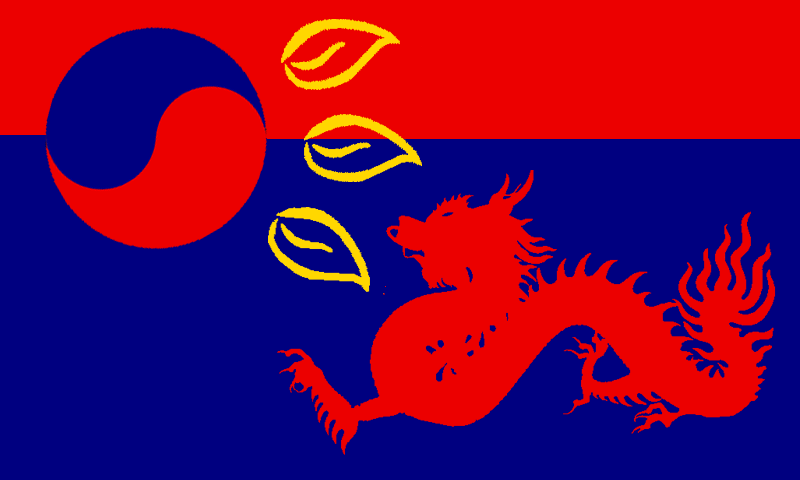Now I present to you my entries for the flag competition. If you have any questions about the symbolism behind any of the things in the flag, be sure to ask~! While I was making them, I stumbled upon a possible origin for our nation's name - at least in-Universe wise.
Tóngzhì De She, used in short-form
Tondeshe, could've been misheard by foreigners or the Nogranians as Toskesh. The word
Tóngzhì means Comrade in Chinese, while the words
De She mean 'Of The' and 'Serpent' respectively. Following that line of logic, our nation's name, when translated, means
'Comrades of the Serpent', symbolizing our tie to the dragons of ancient China and it's mythology. Note this isn't entirely grammatically correct, since I don't speak a word of Chinese, and is more along the lines of creating some culture for us which makes sense and is internally consistent.
Now onto the flags!
First Iteration:
Second Iteration, Golden:
Second Iteration, National Color:

This flag incorporates three unequal horizontal stripes in two colors - red and naval blue - representing ... WIP
Second Iteration, Large:
Third Iteration, Without Dragon:
Third Iteration, With Dragon:

The design is a solid field of naval blue, symbolizing the ocean the people of Toskesh crossed to reach this land and the sky before twilight, adorned with an emblem taking up most of the canvas. The red is a traditional revolutionary symbol dating before the popular bolshevik revolution of 1917, and its incorporation into the flag pays tribute to the international aspect of workers' revolution, while the gold lotus leaves represents the divine, spiritual beauty and the completeness of the union, as well as the the three pillars of Tondesh society. The lower piece of the emblem features a dragon, representing the excellency, endurance and outstanding nature of the people, comrades of the dragons, and describes them as those possessing power, strength, and good luck for people who are worthy of it. The emblem features a red and blue taijitu symbol which is located in the upper hoist quarter, representing the Toskesh Communist Party, and its position over the dragon symbolises its leading role in Toskesh's socialist society to unify and enlighten the workers and peasants in the building of communism. Golden lotus leaves sit to the right of the taijitu, with which they form a lotus flower whose unfolding petals suggest the expansion of the soul. The growth of its pure beauty from the mud of its origin holds a benign spiritual promise to Toskesh people, and like the Proletarian, while growing from mud (the imperial system that preceded it), it is unstained.
Third Iteration, Prosperity:
Fourth Iteration, Original:
Fourth Iteration, Red:
Fourth Iteration, Gold:
Fourth Iteration, Hammer and Sickle:

The design is a solid field of naval blue, symbolizing the ocean the people of Toskesh crossed to reach this land and the sky before twilight, adorned with a red and gold emblem taking up most of the canvas. The red is a traditional revolutionary symbol dating before the popular bolshevik revolution of 1917, and its incorporation into the flag pays tribute to the international aspect of workers' revolution, while the gold represents the completeness of the union, the Sun and the hard work of the workers. The lower piece of the emblem features two dragons holding a hammer and sickle, respectively, representing the union of the golden dragon holding the hammer (workers) and red dragon holding the sickle (peasants) and their victorious and enduring revolutionary alliance. In the Chinese language, excellent and outstanding people are compared to a dragon, who is also a symbol of power, strength, and good luck for people who are worthy of it. The emblem is topped by a red and yellow taijitu symbol representing the Toskesh Communist Party, the unity of the Proletarian class and the Sun. The red hammer symbolises urban industrial workers while the golden sickle symbolises agricultural workers (peasants)—who together, as the Proletarian class, form a state in balance. The taijitu represents the Communist Party, and its position over red and gold dragons symbolises its leading role in socialist society to unify and enlighten the workers and peasants in the building of communism. The lotus leaves surrounding the taijitu represent an example of divine beauty. Its unfolding petals suggest the expansion of the soul . The growth of its pure beauty from the mud of its origin holds a benign spiritual promise, and like the Proletarian, while growing from mud (the imperial system that preceded it), it is unstained.
Fifth Iteration:
Designs:
Xi-52 Dài-I Zha-Buqiang (3): Thanik, Taricus, Thanatos Russ
Type-52 Páoxiāo de léi shēng RGL (1): Lightforger
Flag Proposals (Multiple Votes Allowed!)
Iteration I (0):
Iteration II
- Golden (0):
- National (1): Thanik
- Large (0):
Iteration III
- Without Dragon (0):
- With Dragon (1): Thanik
Iteration IV
- Original (0):
- Gold (0):
- Red (0):
- Hammer and Sickle (1): Thanik
Iteration V (0):

 Author
Topic: Arms Race: Iron Behemoths - Toskesh - GAME OVER (Read 47712 times)
Author
Topic: Arms Race: Iron Behemoths - Toskesh - GAME OVER (Read 47712 times)
